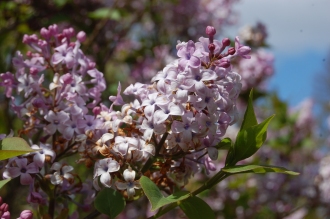
Syringa oblata (23/04/2015, Kew Gardens, London)
Position: Full sun to partial shade
Soil: Moist, well drained
Flowering period: Spring
Eventual Height: 5m
Eventual Spread: 5m
Hardiness: 3a, 3b, 4a, 4b, 5a, 5b, 6a, 6b, 7a, 7b, 8a
Family: Oleaceae
Syringa oblata a deciduous shrub with a spreading habit. Its dark green leaves are ovate entire margins, up to 10cm long and 8cm broad. Its pale lilac fragrant flowers are arranged as conical terminal panicles, are up to 10cm long and 8cm across. Its brown fruit is a dry capsule which is up to 15mm long. Its roots may produce suckers.

Syringa oblata Flower (23/04/2015, Kew Gardens, London)
Syringa oblata, commonly known as Broadleaf Lilac and Early Blooming Lilac, is native to China and Korea. In its native habitat it grows in thickets and woodland margins.
Syringa is derived from the Greek syrinx meaning ‘a tube’, possibly alluding to its hollow stems. Oblata is derived from the Latin oblatus menaing ‘somewhat flattened at the ends’.
The landscape architect may find Syringa oblata useful as a free flowering shrub with an attractive scent. It is a suitable shrub for using to create a deciduous hedge.
Ecologically, Syringa oblata flowers are attractive to pollinating insects including bees.

Syringa oblata Leaf (23/04/2015, Kew Gardens, London)
Syringa oblata prefers moist, humus rich, well-drained soils. It tolerates most pH of soil, although it prefers slightly acidic soil.
Syringa oblata requires little maintenance. Flowers may be removed after they have faded and before they set seed to increase flowering the following year. Any necessary pruning should be carried out after flowering. Syringa oblata flower on old wood and will produce more flowers if left unpruned. Over mature specimens may be rejuvenated by pruning the plant hard to encourage vigorous new growth.

Landscape Architecture











